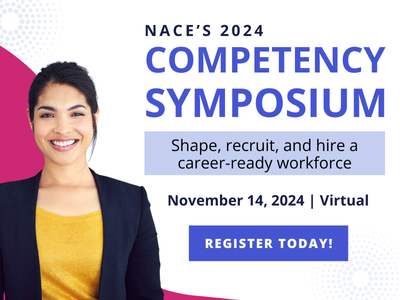Spotlight for Career Services Professionals
Pair-up-and-practice is one way to help students perfect their elevator pitches, but are there activities that add form, function, and/or fun to this introductory lesson? A director of career development asked colleagues to share their experiences in the NACE Community.
A standard go-to is real-time practice: A student recites a 60-second (or less) professional introduction while riding up (or down) in an elevator. The elevator ride ensures that the maximum time allowed is limited. Add an employer to the mix and the student can get feedback needed to polish the professional introduction to perfection.
At the University of Wisconsin-Madison, Professor Greg Downey created a three-statement template that students can use to formulate their pitches, says Michael Kruse, alumni relations coordinator. Each statement is short.
- The first statement covers the present— "I'm a junior at [name of school] studying [major]. In my spare time I also volunteer/participate in [name volunteer or student organization].”
- The next statement offers a glimpse at the student’s experience—“Last summer, I did an internship with [local business] where I worked on [name a cool project].”
- The third statement gives a view of the student’s future—"I'm looking for a full-time position with [some type of company] where I can use my skills in [awesome skills].”
“Use a soft ball or crush a piece of paper into a ball, throw it to one student, and say ‘Past,’ ‘Present,’ or ‘Future,’ ” Kruse says. “The student who catches the ball then has to say [his or her] name and the portion of their elevator pitch that you called out. Then, [he or she] throws it to another student and call out some portion of the pitch to say. You can have students say their whole pitch for the final round of throws.
“Don't give the students too much time to perfect their statements, because they'll refine them as the game goes on. Students benefit from hearing each other and will improve their pitches as the game goes on.”
Other career services colleagues offered suggestions.
At one university, peer counselors go to the cafeteria and practice their pitches to random diners—and offer a quick lesson to those who want to develop their own pitch. At the same school, professional staff wait outside the cafeteria for students who want to practice their elevator pitches. Those who participate are entered into a raffle.
Another practitioner suggested using speed networking to help students hone their pitch. Two to four students sit with an employer at a pub table and each gives a pitch. The employer critiques the pitches. Then, students move to the next table and employer where they offer a more polished pitch that incorporates the first employer’s suggestions. Again, students rotate to a new table and new employer—going to five or more tables and updating their elevator pitch each time.
A third school offers a workshop on elevator speeches and combines it with information on how to navigate receptions. Student participants return in a week for a reception with employers who are already on campus for interviews. Faculty and staff also attend the reception. Students are challenged to approach two employers with their pitches. Then, an employer panel presents feedback on the pitches and answers student questions.
At another college, students begin work on their pitches during their first-year seminar. Students get a bio of a fictional student and are asked to decide which parts of the student’s bio are appropriate to include in a pitch—and which aren’t necessary. This helps students understand the format and timing needed for a successful pitch.
How do you help students formulate their elevator pitches? Add your thoughts in the NACE Community.






